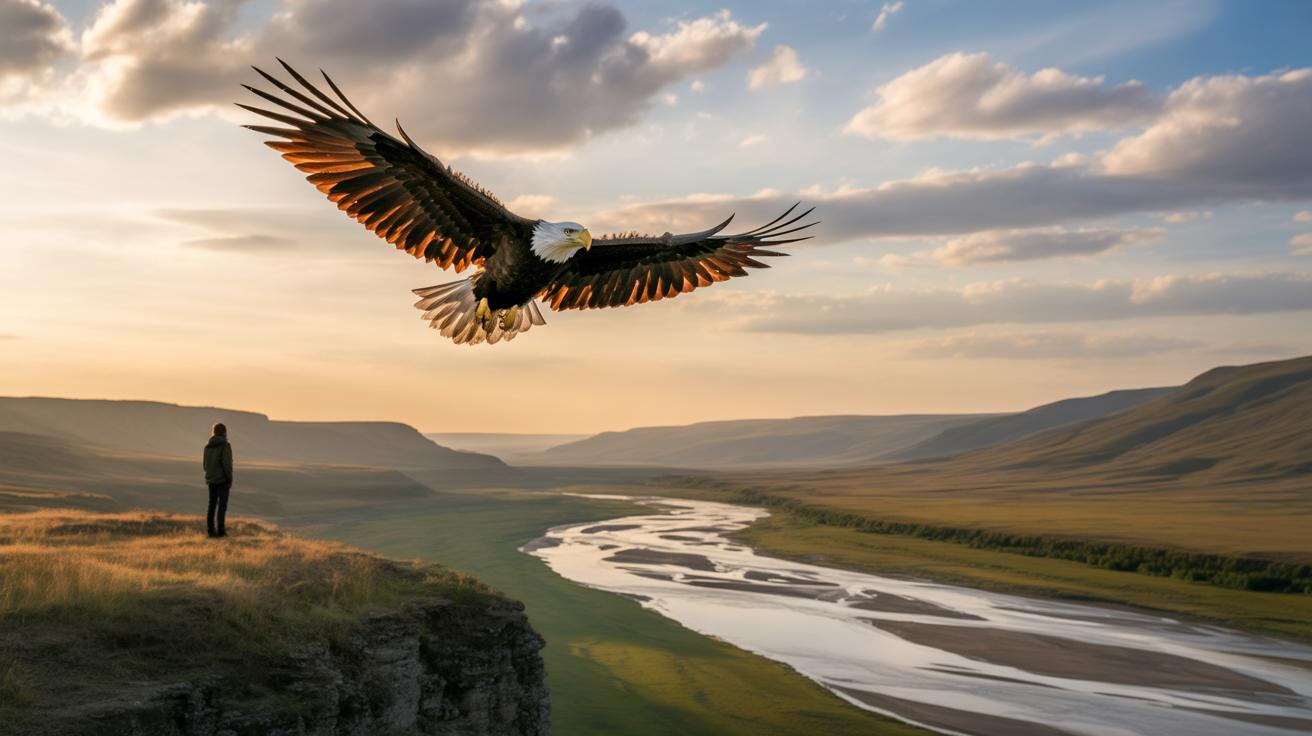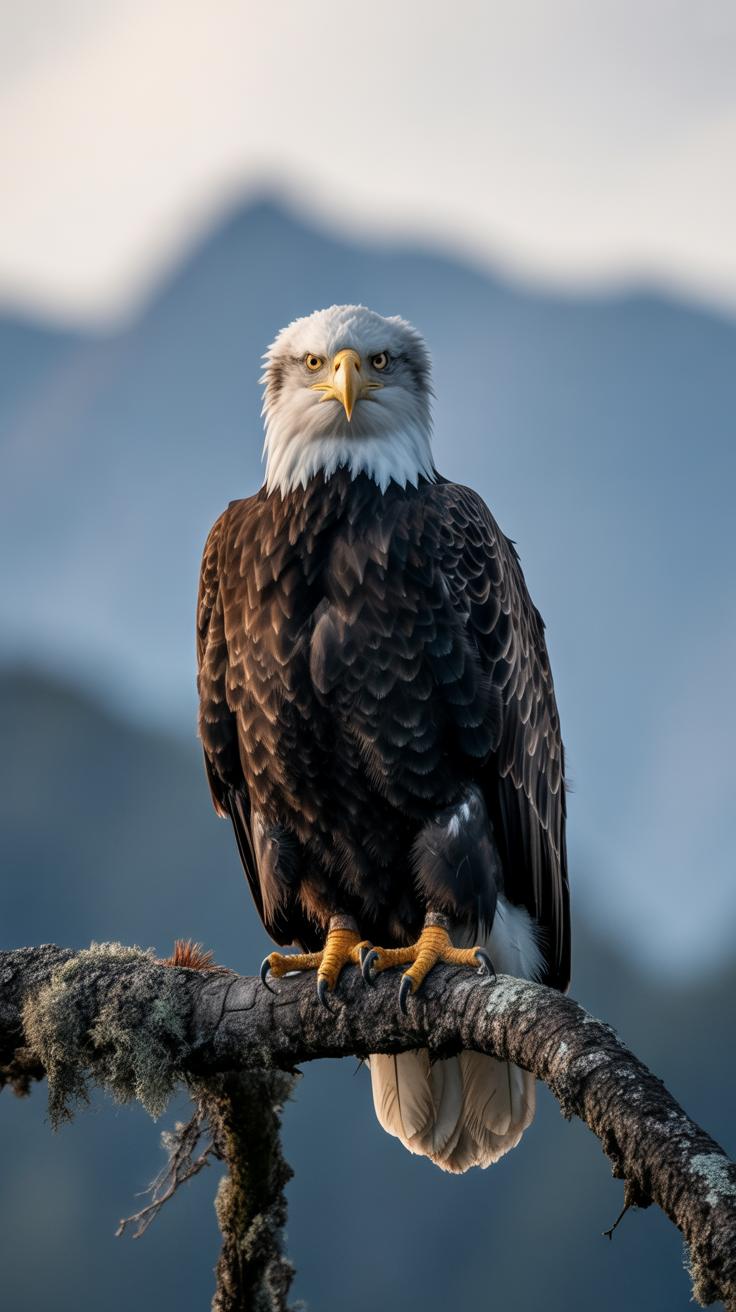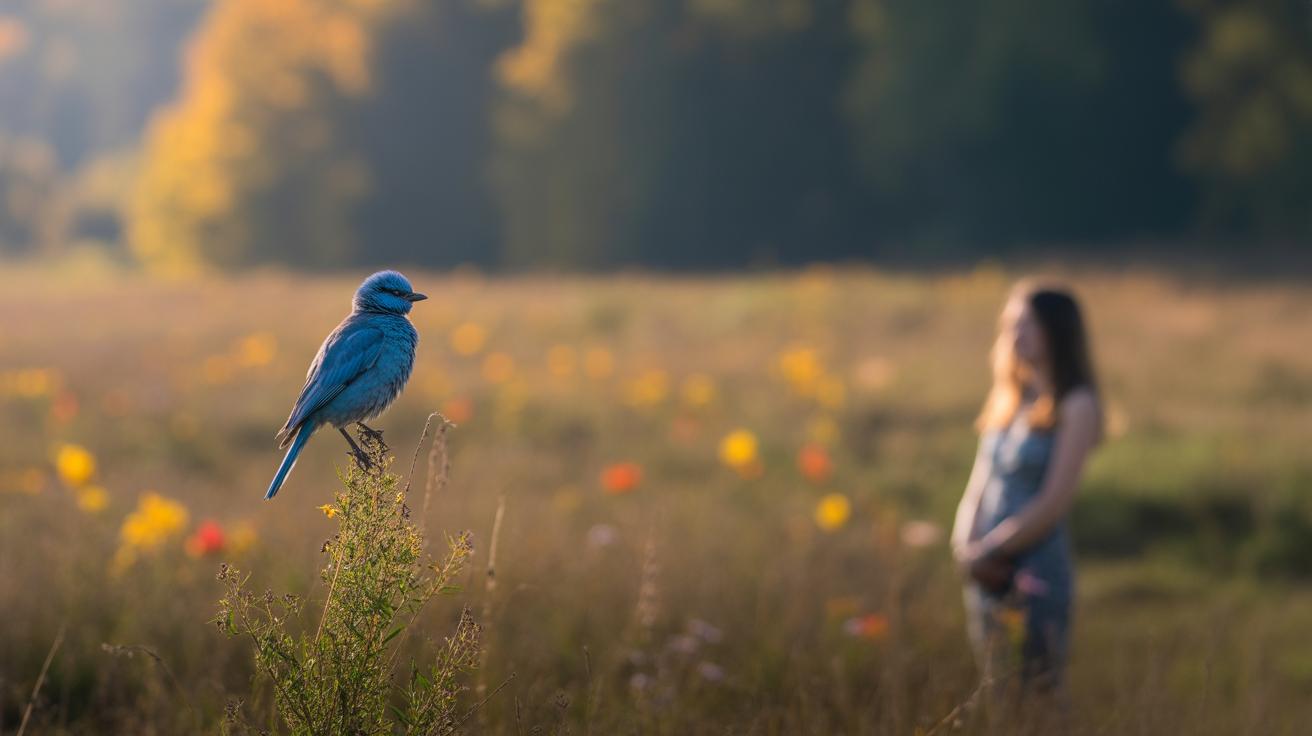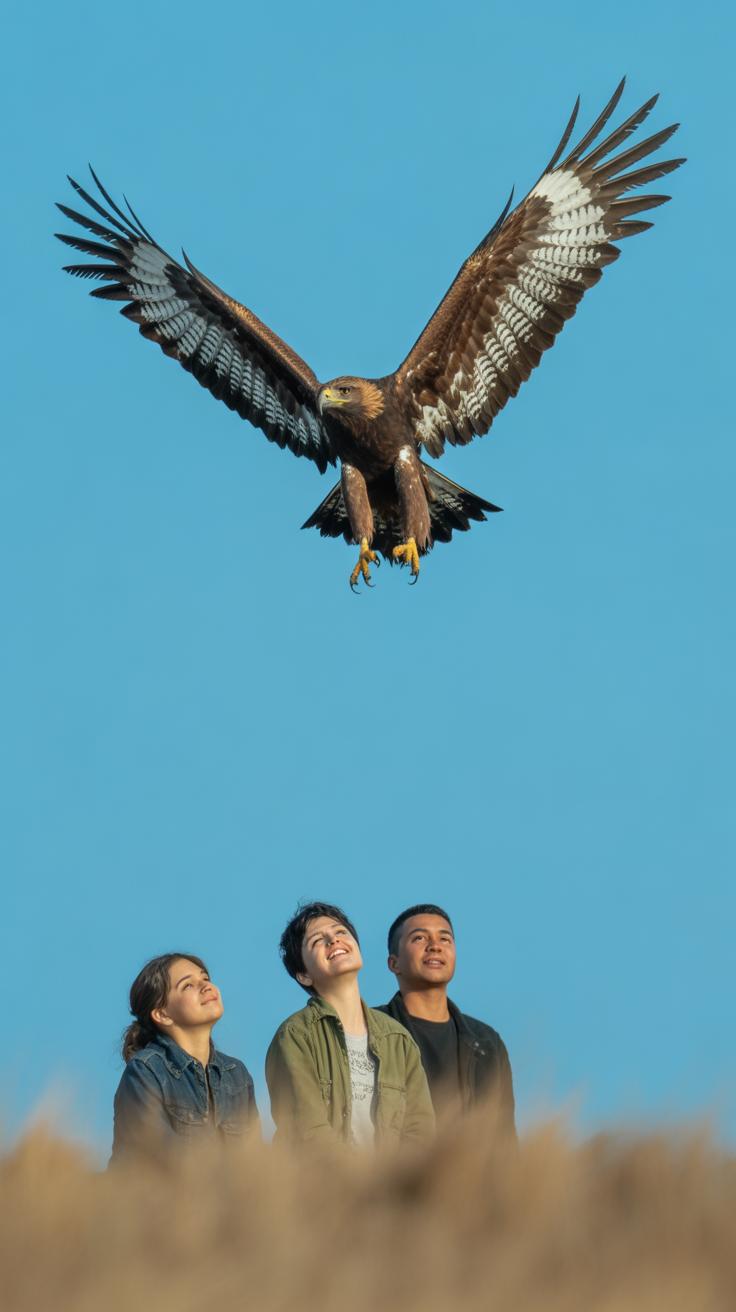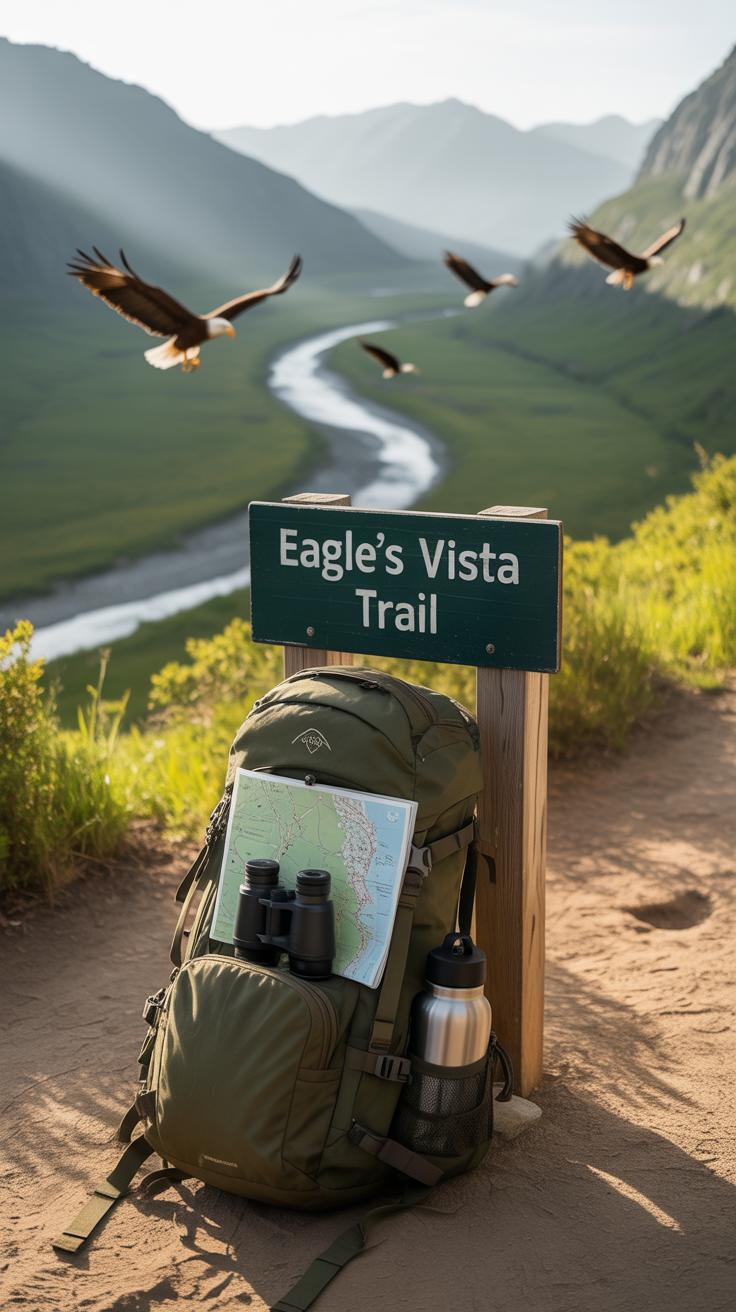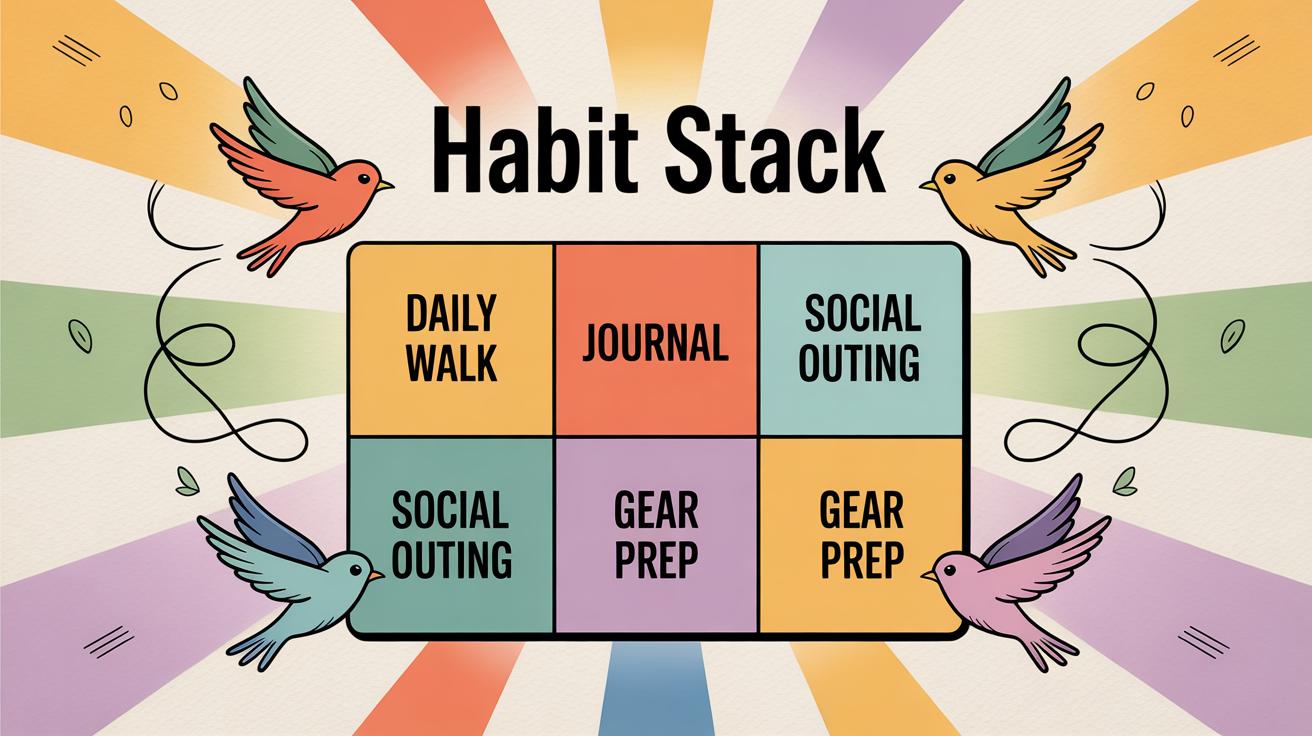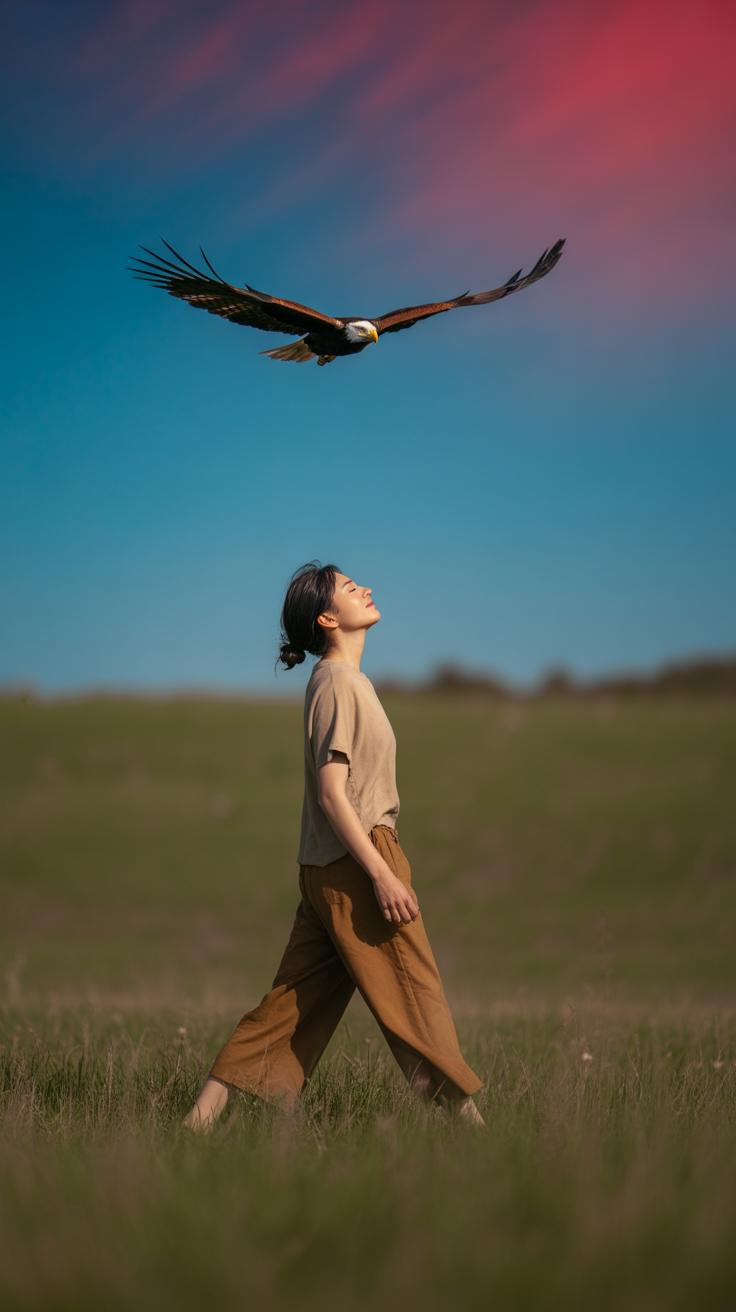Introduction
Bald eagle sightings have long inspired people with their powerful presence and striking appearance. Watching these majestic birds in the wild can awaken a strong feeling of awe, a deep sense of wonder that connects us to nature. This feeling of awe not only brings joy but also has real benefits for mental health.
In this article, we will explore the details of bald eagle behavior and habitats. We will then look at what awe is and how experiencing it can improve your wellbeing. You will learn practical ways to seek out these moments of awe and enhance your mental health through nature.
Bald Eagle Appearance and Characteristics
Physical Traits of Bald Eagles
The bald eagle stands out with its striking colors and sizable frame. Adult eagles show a sharp contrast—a white head and tail set against a dark brown body and wings. This color pattern makes them relatively easy to spot from a distance, especially when they perch against the sky or trees. Interestingly, the pure white head doesn’t develop until they are about five years old, so younger birds often confuse observers with their mottled brown and white plumage.
When it comes to size, females typically outweigh males by a noticeable margin. Females can reach lengths of around 35 inches with a wingspan up to 8 feet, while males are somewhat smaller. This size difference—perhaps linked to their nesting roles—means that a large, shadow-casting bird overhead is often a female. Apart from size, their massive yellow beak and sharp, curved talons are hard to miss. These features aren’t just for show—they’re essential tools.
How Their Appearance Supports Survival
Their physical traits offer more than a commanding presence. For instance, the hooked beak, powerful and thick, slices through prey with surprising ease. It helps in tearing flesh and managing different types of food. Their talons can grip slippery fish or small mammals tightly, preventing escape during flight. Wings large and broad aid soaring, allowing these birds to conserve energy while scanning large areas for food.
One might wonder if the white head serves a practical purpose beyond identification. Some think it could play a role in mating displays or social signaling within eagle communities, while others see it as mere coincidence of evolution. What is clear, though, is the combination of their plumage, size, and strong physical features makes bald eagles impressive hunters that thrive throughout diverse environments.
Bald Eagle Habitats and Range
Bald eagles live mostly near large bodies of open water with abundant fish, their primary food. They prefer environments like lakes, rivers, reservoirs, and coastal shorelines where fish are easy to catch. These birds need wide spaces for hunting but also require tall, sturdy trees for nesting and resting. You might notice that not every forest works for them; it’s really about proximity to water combined with good perching spots.
Across North America, their range covers most of Canada, the United States, and parts of northern Mexico. They are especially common along the Pacific Northwest coast, the Great Lakes region, and Alaska. Southern areas tend to have fewer eagles but sightings still happen in some river valleys and wetlands. So, while they’re spread out, their presence is not uniform everywhere you might hope.
If you’re hoping to spot a bald eagle, look where these habitat features come together:
- Clear, fish-rich water bodies like slow-moving rivers or large lakes.
- Clusters of tall trees—often conifers or large hardwoods—for nesting.
- Minimal human disturbance, since eagles can be wary of heavy activity nearby.
These birds rely on these conditions to raise their young and thrive. The connection between water, food supply, and tall trees forms an ecosystem that supports their survival. If any one element is missing, their chances of sticking around lessen.
Bald Eagle Behavior and Diet
Bald eagles have interesting habits when it comes to feeding and survival. They spend a lot of time soaring high above water, scanning for movement. Their vision—honestly, it’s something to wonder about—is sharp enough to spot fish from great heights. Once they lock onto a target, the real action begins. They dive fast, stretching out their talons like claws ready to grip tightly. It’s striking how they snatch fish right from the water’s surface without missing much, though I guess sometimes they miss, too.
These birds prefer fish as their main meal, with species like trout, salmon, and catfish topping the list. Yet they’re far from picky and will consume birds, small mammals, and carrion if fish get scarce. I find it curious that during harsh winters, when fishing is tough, they don’t just starve—they resort to scavenging quite readily, even stealing prey from other birds. That flexibility seems key to their survival, though it might seem like a simple fallback strategy. Still, it shows how adaptive they really are.
Trusting their talons and sight alone isn’t all they do. Sometimes bald eagles perch quietly, waiting for an opportunity, or they might steal a meal by intimidating other animals. Watching this mix of patience and sudden speed makes you realize how complex their behavior is, not just a straightforward predator. It makes you wonder what goes through their heads as they decide when, where, and how to catch their next meal.
The Meaning of Awe and Its Connection to Nature
What is Awe
Awe is that sudden, deep feeling you get when something feels much bigger than yourself. It’s mix of surprise, wonder, and a slight edge of fear—or maybe respect. You might feel small or quiet, almost like your usual thoughts pause for a moment. It’s not just happiness or admiration, but something a bit more intense, pulling you out of your normal perspective. When people talk about awe, they often mention a sense of vastness or something hard to put into words. It’s like your mind trying to catch up with what you’re seeing or experiencing but not quite managing.
When you see a bald eagle soaring high, you might feel this. Your heartbeat slows, your breath catches, and suddenly, the usual day-to-day worries seem less important. You might feel humbled or inspired, or both at once.
How Nature Triggers Awe
Nature has a way of snapping us out of routine. Things like tall mountains or a clear night sky can leave you staring, just absorbing the scene. Bald eagles, in particular, stir something in people. Their size, the way they glide smoothly without effort, their piercing gaze—all of it signals something bigger and older than us. Watching them, you recognize a story of survival, freedom, and power that stretches beyond your own experience.
These moments nudge you toward thinking about where you fit in the world. They connect you to something larger, even if it’s only for a brief moment. And this connection often feels mix of uplifting and grounding. It’s strange how something wild and untouchable can have that effect—like a quiet reminder that life isn’t just about daily tasks or personal struggles.
Have you ever paused just to watch an eagle circle overhead? If so, you might remember feeling a bit uneasy and amazed at once. That’s awe working its way into your mind, inviting you to see the world differently, even if just for a few seconds.
How Awe Benefits Your Mental Health
There’s something about awe that reaches deep into how we feel, often without us even noticing right away. When you stop for a moment—maybe while watching a sunset or glimpsing a starry sky—your body and mind shift. Scientists have found that such moments, when you feel awe, actually lower stress hormones. That means your heart rate slows down, your breathing steadies, and sudden worries seem less urgent.
If you think about it, awe kind of acts like a reset button for your brain. Studies reveal that experiencing awe can reduce inflammation and calm the nervous system. It’s not just a fleeting moment of “wow”—it triggers real biological changes that ease anxiety and lift your mood, often for hours afterward.
But here’s where it gets even more interesting: awe doesn’t just help you chill out. It also nudges your brain toward positive emotions. When you feel awe, you often feel connected. Connected to people, connected to nature, almost as if you’re part of something bigger. That feeling makes you more compassionate, more inclined to trust others—or even just more patient during a stressful day.
Have you ever noticed how sharing a beautiful experience makes it feel even better? That’s awe at work. It tends to strengthen social bonds because it makes you want to share the experience, but it also reminds you that you’re not alone. The world feels less isolating when awe is present.
- Stress melts away as awe regulates your body’s reaction to pressure.
- Awe sparks feelings of happiness and gratitude that linger.
- It encourages a sense of connection—to people around you and to the natural world.
- Through awe, everyday concerns seem smaller, letting you breathe easier.
It’s strange how something so simple—a fleeting feeling—can ripple through your mental health in these ways. Maybe next time you feel awe, pause and see what it does to your mood. It’s not magic, exactly, but it’s close enough.
The Role of Bald Eagle Sightings in Creating Awe
The Impact of Seeing a Bald Eagle
There’s something about spotting a bald eagle that catches you off guard. Maybe it’s the size—these birds look massive even from a distance. Their white heads and tails stand out sharply against the sky or the trees, making them unmistakable. When you see one soaring or perched nearby, it often feels like a rare and privileged moment. People talk about a sudden stillness, a quiet energy that isn’t easy to describe. You might feel small, in a good way, like you’re witnessing something bigger than yourself. Some say it’s a mix of excitement and calm, almost like nature is reminding you of its vastness and resilience.
It’s not just their look but the way bald eagles move—the slow, deliberate wingbeats, the piercing gaze. You might catch yourself holding your breath, watching how they scan the surroundings with such focus. When it happens, you often feel a nudge toward something contemplative or even hopeful.
How Bald Eagles Represent Strength and Freedom
Bald eagles carry powerful meanings that people bring to their encounters. They commonly embody strength. Think about their sharp talons, broad wings, and commanding presence—they suggest a resilience that’s hard to ignore. To many, they represent freedom—the ability to fly high, unrestricted in the open sky. This symbolism isn’t invented out of nowhere; it has deep roots in various cultures, especially in the U.S., where the bald eagle is a national symbol. But even beyond that, individuals see them as reminders of perseverance or independence in their own lives.
Sometimes, these associations intensify the feeling of awe. You aren’t just looking at a bird; you’re connecting to larger ideas—power, liberty, survival—that it represents. And that connection can be strangely comforting or uplifting, even if you only glimpse the eagle for a few moments.
Planning Your Own Bald Eagle Sightings
Best Places and Times to See Bald Eagles
If you want to catch a glimpse of bald eagles, some spots stand out more than others. Places near large bodies of water tend to be the best—rivers, lakes, or coastal areas where fish are abundant. For example, the Pacific Northwest, particularly around the Columbia River Gorge, offers frequent sightings during winter months when eagles gather to feed.
In the eastern US, places like Chesapeake Bay and parts of the Great Lakes region also attract many eagles, especially in late fall through early spring. The colder months seem to bring more visibility since eagles cluster near open water not frozen over yet.
Timing can be tricky though. Early morning or late afternoon often feel like prime eagle hours, as they’re more active flying and hunting then. Still, patience matters—sometimes you might wait for hours without seeing anything, and other times eagles just appear out of nowhere.
How to Prepare for Eagle Watching
Bring binoculars or a good zoom lens if you can; those help catch details without disturbing the birds. Dress in layers and wear comfortable shoes—watching can involve standing or walking on uneven terrain. Don’t forget water and some snacks, especially if you plan to stay long enough to increase your chances.
Also, think about respecting the eagle’s space. Keep a good distance and avoid sudden movements or loud noises. That not only protects the bird but also your chance to enjoy uninterrupted observation. Sometimes, I found just sitting quietly near the water’s edge made eagles feel less threatened and allowed me closer views.
Finally, check weather and local regulations. Some eagle habitats are protected areas with specific rules to follow. Planning ahead keeps you safe and ensures the experience stays special—for you and the eagles alike.
How to Enhance Awe Experiences During Nature Sightings
Using Mindfulness to Amplify Awe
When you spot a bald eagle soaring or perched silently, it’s easy for your mind to wander—thinking about what’s next or distractions pulling you away. Mindfulness can help anchor you right there, fully present. Try this: slow your breathing and focus on the eagle’s movement or the way sunlight hits its feathers. Notice details—the shape of its wings, the sharpness of its gaze. This kind of focused attention pulls you deeper into the moment, making the experience more vivid, more awe-inspiring.
Sometimes, just pausing your thoughts—letting them settle like leaves on water—can open you up to feelings you didn’t expect. It’s almost like the world becomes sharper, yet softer at the same time. You might find yourself feeling more connected, even calm, simply by watching with this quiet, mindful focus.
Engaging Your Senses Fully
Observing bald eagles is not just a visual experience. If you stretch your awareness, other senses come alive. What sounds fill the air? Maybe the quiet rustle of trees, distant calls of birds, or the faint wind brushing your skin. Notice the temperature—maybe crisp or warm. Feel the earth beneath your feet or the texture of a nearby branch if you’re resting your hand.
Try to see beyond just the eagle itself. Inhaling deeply, what does the air smell like? Fresh pine, damp earth, or something faintly smoky? These small sensory details stitch the moment together, making it richer. When I first stood watching an eagle while focusing on these little things, the feeling lingered longer than usual. It wasn’t just seeing a bird—it was immersing myself in a place, in a time.
Could paying attention to these subtle senses change how often you feel awe? It’s something worth exploring each time you step outside to watch.
Incorporating Awe Moments into Daily Life
You don’t need to travel far or wait for a bald eagle sighting to feel awe. Sometimes, the ordinary holds tiny sparks of wonder, if you pay close enough attention.
Look for these moments near your home:
- The way sunlight filters through leaves in the morning, casting uneven patterns on the ground.
- Watching clouds shift shape slowly, almost like they’re breathing.
- Listening to birdsong during a quiet pause, letting the complexity surprise you.
- Feeling the texture of bark or the roughness of a stone beneath your fingers.
- Noticing the night sky on a clear evening, with distant stars scattered beyond reach.
Capturing these fragments of awe can be easier than you think.
Try creating small rituals around them. For example:
- Pause for a moment each day just to really see something natural around you—maybe a plant on your windowsill or the changing sky.
- Keep a simple journal and jot down one thing that made you stop or wonder each day, no matter how small.
- Set reminders on your phone—not to check emails, but to breathe deeply and notice what’s around you.
- Before bed, take a minute to express quiet gratitude for something you saw or felt that inspired you during the day.
At times, these routines may feel forced or trivial, but building them gradually can open your mind to noticing small wonders. And, frankly, your mental space might need that gentle tug away from routine now and then. It’s an invitation more than a task, really.
Using Awe to Support Your Ongoing Mental Health
Regular experiences of awe can slowly become a quiet anchor in your mental health routine. It’s not just about feeling good for a moment—it’s about layering those moments over time until they build something more lasting.
Think about how spotting a bald eagle, majestic and silent in flight, can briefly turn your attention outward, away from everyday worries. If you can seek that feeling often enough—whether through nature, art, or small personal discoveries—it sets a gentle rhythm for your mind.
The long-term benefits aren’t flashy. They can show up as less irritability, or maybe a small increase in your ability to concentrate. There’s research hinting that awe encourages openness and curiosity, qualities that keep your mindset flexible, even during rough patches.
It may not eliminate stress completely but imagine it as a subtle shield, strengthening your mental muscles by giving you frequent glimpses of something bigger than yourself. That, more than anything, seems to help keep mental health steady through ups and downs.
Building Resilience Through Awe
Awe seems to act like a kind of emotional reboot. When stress and difficult feelings pile up, awe can pull you out of that loop, even briefly. It changes your perspective—reminding you that whatever you’re facing is part of a larger picture.
People often feel they bounce back faster after awe experiences, though it’s hard to pinpoint exactly why. Maybe it makes adversity feel smaller or less personal. Or maybe it sparks a sense of wonder that overshadows the immediate struggle.
It’s not that awe erases pain, but it can soften it. After watching a bald eagle soar overhead, for instance, your mind might feel less stuck, a bit more ready to handle what’s next. It’s almost as if awe interrupts negative thought patterns and gives your brain a rest.
Maintaining a Positive Outlook
Over time, regularly experiencing awe encourages a mindset that leans toward hope and happiness. This doesn’t mean you’ll feel joyful all the time—life’s too complicated for that—but awe helps you find reasons to believe things can improve.
What’s interesting is that awe often brings humility alongside hope. When you witness something vast or powerful, it reminds you there’s more to life, which can make your own challenges seem less overwhelming. That perspective nudges your thinking towards optimism.
So, by weaving awe into your life, you’re not chasing fleeting joy but nurturing a wider, more patient kind of happiness. It’s a slow-moving current that can shift how you view your world—making it, perhaps, a little easier to face each day.
Conclusions
Seeing bald eagles in their natural environments can give you a unique chance to feel awe. This emotion helps you feel closer to nature and can reduce stress, increase happiness, and promote a positive outlook. The combination of the eagle’s impressive presence and the feeling of awe can lift your mood and refresh your mind.
By understanding bald eagles and the power of awe, you can make intentional choices to spend time outside and seek these uplifting moments. This simple habit can support your mental health every day. Remember, nature offers powerful tools for wellbeing, and bald eagle sightings are one special way to tap into that.

